MGA Archaeology – Engine Block and Head
Sept/Oct 2024 V50/N01
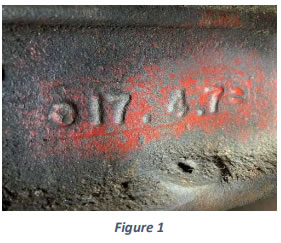 Early last year I did a presentation on MG Archaeology at the Kimber Festival held at the Simeone Foundation in Philadelphia, PA. I covered all MGs basically, but many of the ideas apply to the MGA, so, here is what I have learned about the MGA engine blocks and heads. As many may know from the merger of Morris and Austin in 1952 to become British Motor Cars (BMC), the company was run by Sir Leonard Lord of Austin (formerly of Morris) and thus the decision was made to use an Austin motor in the new MGA. This particular design was created at Austin in 1947 and after several iterations and redesigns we get the 1489cc used first in the ZA Magnette but then with a few more mods in the 1956 MGA (production starting in 1955). I can’t say for sure when the engine blocks started carrying casting dates, but I do have examples of dates in the DD/MM/Y format for 1957 and 1958. See Figure 1.
Early last year I did a presentation on MG Archaeology at the Kimber Festival held at the Simeone Foundation in Philadelphia, PA. I covered all MGs basically, but many of the ideas apply to the MGA, so, here is what I have learned about the MGA engine blocks and heads. As many may know from the merger of Morris and Austin in 1952 to become British Motor Cars (BMC), the company was run by Sir Leonard Lord of Austin (formerly of Morris) and thus the decision was made to use an Austin motor in the new MGA. This particular design was created at Austin in 1947 and after several iterations and redesigns we get the 1489cc used first in the ZA Magnette but then with a few more mods in the 1956 MGA (production starting in 1955). I can’t say for sure when the engine blocks started carrying casting dates, but I do have examples of dates in the DD/MM/Y format for 1957 and 1958. See Figure 1.
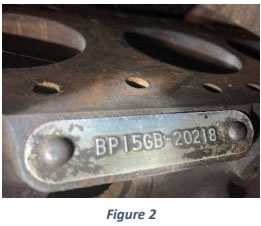 This appears on the right side of the block just above the sump bolts and below the oil filter. The engine part number also provides information but we won’t go into that now. The Engine number just below the head on a casting on the right side of the motor is the main identifier, but this often goes missing in an engine rebuild. Earlier MGAs can have this number also on the VIN ID plate on the heater shelf in the engine compartment but starting about 1958 the factory just put “See Engine” on the plate. So, one can get a build sheet (certificate) from British Motor Heritage and often this will also have the original engine number for the car along with the build date of the car. See Figure 2.
This appears on the right side of the block just above the sump bolts and below the oil filter. The engine part number also provides information but we won’t go into that now. The Engine number just below the head on a casting on the right side of the motor is the main identifier, but this often goes missing in an engine rebuild. Earlier MGAs can have this number also on the VIN ID plate on the heater shelf in the engine compartment but starting about 1958 the factory just put “See Engine” on the plate. So, one can get a build sheet (certificate) from British Motor Heritage and often this will also have the original engine number for the car along with the build date of the car. See Figure 2.
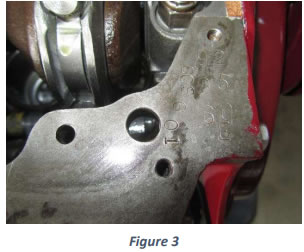 Starting with the MGA 1600 in 1959 the engine was re-cored with thicker cylinder walls to bore to 1588cc but kept the same head with a 15 cast at the rear of the top of the head. They also stopped using the date on the side of the block and instead stamped it on the mating surface for the sump. It can be on either side of the front surface or either side of the rear surface. The example here is near the oil pressure relief valve. There a several numbers there including the year in YY format. The other numbers are thought to be batch number and number in batch along with perhaps an inspector’s number. This needs more research. This was carried on through the MGA 1600 MKII engine blocks. See Figure 3
Starting with the MGA 1600 in 1959 the engine was re-cored with thicker cylinder walls to bore to 1588cc but kept the same head with a 15 cast at the rear of the top of the head. They also stopped using the date on the side of the block and instead stamped it on the mating surface for the sump. It can be on either side of the front surface or either side of the rear surface. The example here is near the oil pressure relief valve. There a several numbers there including the year in YY format. The other numbers are thought to be batch number and number in batch along with perhaps an inspector’s number. This needs more research. This was carried on through the MGA 1600 MKII engine blocks. See Figure 3
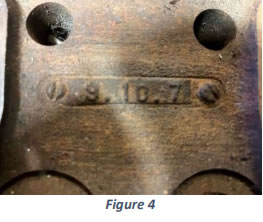 The heads for the engines were marked with a DD/MM/Y format on the earlier 1500 heads (See Figure 4) but sometime in 1600 production (still with a 15 head) the date code changed into a “clock” format with the DD at the top, MM to the left and YY to the right. This did not conform to the Ferrous Metals casting date code standard that later used a letter and sometimes a single digit for the year and sometimes two digits. In any case it does help identify if the head is original to the engine and car. See Figure 5. Early MGA 1600 MKII engines had the 1500 head as well but soon switched to a new head with large valves. I have not found which engine number this change occurred, but perhaps someone will let me know. This new head was designated with a 16 at the top rear of the head and will have a “clock” style date code.
The heads for the engines were marked with a DD/MM/Y format on the earlier 1500 heads (See Figure 4) but sometime in 1600 production (still with a 15 head) the date code changed into a “clock” format with the DD at the top, MM to the left and YY to the right. This did not conform to the Ferrous Metals casting date code standard that later used a letter and sometimes a single digit for the year and sometimes two digits. In any case it does help identify if the head is original to the engine and car. See Figure 5. Early MGA 1600 MKII engines had the 1500 head as well but soon switched to a new head with large valves. I have not found which engine number this change occurred, but perhaps someone will let me know. This new head was designated with a 16 at the top rear of the head and will have a “clock” style date code.
In the example in figure 5 since all the values are numeric it is easy to see that it is 12/8/60 thus it was cast on August 12, 1960. It probably went into a 1960 MGA around October of that year given that it takes about a couple months for the block to be machined, assembled into a motor and then sent to the final assembly plant (in this case Abingdon, UK).
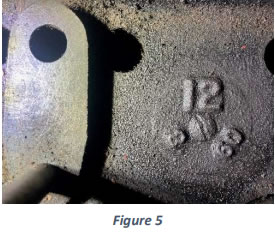 With these numbers in mind one can tell if the engine date and number are within range of the production date of their car and if later then they know it is a replacement OR if the wrong type of motor or way too early a date then also a replacement not original to the production date of the MGA.
With these numbers in mind one can tell if the engine date and number are within range of the production date of their car and if later then they know it is a replacement OR if the wrong type of motor or way too early a date then also a replacement not original to the production date of the MGA.
In conclusion, this information may help determine originality of a particular MGA and may be of interest to the purists in the MGA community. For those who have transplanted some other engine or other components into their car this may not be of much importance.
Written by Fred Horner, February 10, 2024.

